Analysis of Erect-Panicle Japonica Rice in Northern China: Yield, Quality Status, and Quality Improvement Directions
Abstract
:1. Introduction
2. Results
2.1. Rice Production and Its Constituent Factors
2.2. Quality and Panicle Traits
2.3. Relationship between the Yield and Quality Traits
2.4. Relationship among the Yield, Quality, and Panicle Traits
2.5. Relationship among the Taste, Yield, and Quality Traits
3. Discussion
3.1. High-Yield and High-Quality Approach for Erect-Panicle Japonica Rice Breeding in Northern China
3.2. Efficient Nitrogen Utilization by Northern Erect-Panicle Japonica Rice
3.3. Improvement in the Taste Quality of Northern Erect-Spike-Type Japonica Rice
4. Materials and Methods
4.1. Plant Cultivation and Harvesting
4.2. Determination of the Processing Quality
4.3. Determination of the Appearance Quality
4.4. Determination of the Nutrition Quality
4.5. Determination of the Taste Quality
4.6. Statistical Analysis
5. Conclusions
Author Contributions
Funding
Data Availability Statement
Conflicts of Interest
References
- Gu, M.H. Discussion on the aspects of high-yielding breeding in rice. Acta Agron. Sin. 2010, 36, 1431–1439. (In Chinese) [Google Scholar]
- Xu, H.; Sun, J.; Xu, Q.; Pan, G.; Zhou, G.; Zhang, Z.; Sun, Y.; Xu, Z.; Chen, W. Research progress on optimizing panicle characters and quality improvement of indica pedigree in northern japonica rice. Chin. Sci. Bull. 2022, 67, 135–142. [Google Scholar] [CrossRef]
- Tang, L.; Chen, W. Development trend and prospect of Geng Rice in Northeast China. China Rice 2021, 27, 1–4. [Google Scholar]
- Zhang, H.; Yu, C.; Hou, D.; Liu, H.; Zhang, H.; Tao, R.; Cai, H.; Gu, J.; Liu, L.; Zhang, Z.; et al. Changes in mineral elements and starch quality of grains during the improvement of japonica rice cultivars. J. Sci. Food Agric. 2017, 98, 122–133. [Google Scholar] [CrossRef] [PubMed]
- Deng, Z.Y.; Qu, L.Q.; Wu, Y.R.; Zhang, J.; Wang, T. Current progress and prospect of crop quality research. Sci. Sin.-Vitae 2021, 51, 1405–1414. [Google Scholar] [CrossRef]
- Gu, M.H.; Cheng, Z.K. Origin, Differentiation and Cytogenetics of Rice; Science Press: Beijing, China, 2020. [Google Scholar]
- Idowu, O.; Wang, Y.; Homma, K.; Nakazaki, T.; Xu, Z.; Shiraiwa, T. Interaction of erect panicle genotype and nitrogen fertilizer application on the source-sink ratio and nitrogen use efficiency in rice. Field Crops Res. 2022, 278, 108430. [Google Scholar] [CrossRef]
- GB/T17891-2017; High Quality Paddy. General Administration of Quality Supervision, Inspection and Quarantine of the People’s Republic of China: Beijing, China, 2018.
- Moon, S.; Chandran, A.K.N.; Gho, Y.-S.; Park, S.-A.; Kim, S.-R.; Yoo, Y.-H.; Jung, K.-H. Integrated omics analysis of root-preferred genes across diverse rice varieties including Japonica and indica cultivars. J. Plant Physiol. 2018, 220, 11–23. [Google Scholar] [CrossRef] [PubMed]
- Mao, T.; Zhang, Z.; Ni, S.J.; Zhao, Y.Z.; Li, X.; Zhang, L.L.; Liu, Y.; Li, X. Analysis of variation patterns in rice milled quality in the offspring of indica–japonica hybridization. Genet. Resour. Crop Evol. 2021, 68, 1785–1797. [Google Scholar] [CrossRef]
- Huang, X.; Qian, Q.; Liu, Z.; Sun, H.; He, S.; Luo, D.; Xia, G.; Chu, C.; Li, J.; Fu, X. Natural variation at the DEP1 locus enhances grain yield in rice. Nat. Genet. 2009, 41, 494–497. [Google Scholar] [CrossRef] [PubMed]
- Sun, H.; Qian, Q.; Wu, K.; Luo, J.; Wang, S.; Zhang, C.; Ma, Y.; Liu, Q.; Huang, X.; Yuan, Q.; et al. Heterotrimeric G proteins regulate nitrogen-use efficiency in rice. Nat. Genet. 2014, 46, 652–656. [Google Scholar] [CrossRef] [PubMed]
- Wang, F.; Peng, S.-B. Research progress in rice green and high-yield management practices. Chin. Bull. Life Sci. 2018, 30, 103–110. [Google Scholar]
- Hu, B.; Wang, W.; Ou, S.; Tang, J.; Li, H.; Che, R.; Zhang, Z.; Chai, X.; Wang, H.; Wang, Y.; et al. Variation in NRT1.1B contributes to nitrate-use divergence between rice subspecies. Nat. Genet. 2015, 47, 834–838. [Google Scholar] [CrossRef] [PubMed]
- Yang, Y.H.; Shen, Z.Y.; Xu, C.D.; Guo, M.; Li, Y.; Zhang, Y.; Zhong, C.; Sun, S.; Yan, C. Genetic improvement of panicle-erectness japonica rice toward both yield and eating and cooking quality. Mol. Breed. 2020, 40, 51–63. [Google Scholar] [CrossRef]
- Nakamura, S.; Cui, J.; Zhang, X.; Yang, F.; Xu, X.; Sheng, H.; Ohtsubo, K.I. Comparison of eating quality and physicochemical properties between Japanese and Chinese rice cultivars. Biosci. Biotechnol. Biochem. 2016, 80, 2437–2449. [Google Scholar] [CrossRef] [PubMed]
- Shi, Y.; Yang, Y.; Li, X.; Li, Q.; Huang, L.; Zhang, C.; Song, X.; Liu, Q. Comparison of grain quality profiles of japonica soft rice varieties with different amylose contents. Chin. J. Rice Sci. 2022, 36, 601–610. [Google Scholar]
- Zhao, C.-F.; Yue, H.-L.; Tian, Z.; Gu, M.-C.; Zhao, L.; Zhao, Q.-Y.; Zhu, Z.; Chen, T.; Zhou, L.-H.; Yao, S.; et al. Physicochemical properties and sequence analysis of Wx and OsSSIIa genes in japonica rice cultivars from Jiangsu Province and northeast of China. Acta Agron. Sin. 2020, 46, 878–888. [Google Scholar] [CrossRef]
- Xu, Q.; Zhao, M.H.; Wu, K.; Fu, X.D.; Liu, Q. Emerging insights into heterotrimeric G protein signaling in plants. J. Genet. Genom. 2016, 43, 495–502. [Google Scholar] [CrossRef] [PubMed]
- Zhang, M. Japan’s food crisis and food diplomacy in the early postwar period. New West 2012, 35–36, 92–94. [Google Scholar]
- GB/T 15682-2008; Inspection of Grain and Oils—Method for Sensory Evaluation of Paddy or Rice Cooking and Eating Quality. General Administration of Quality Supervision, Inspection and Quarantine of the People’s Republic of China: Beijing, China, 2009.
- Dunnett, C.W. A multiple comparison procedure for comparing several treatments with a control. J. Am. Stat. Assoc. 1955, 50, 1096–1121. [Google Scholar] [CrossRef]
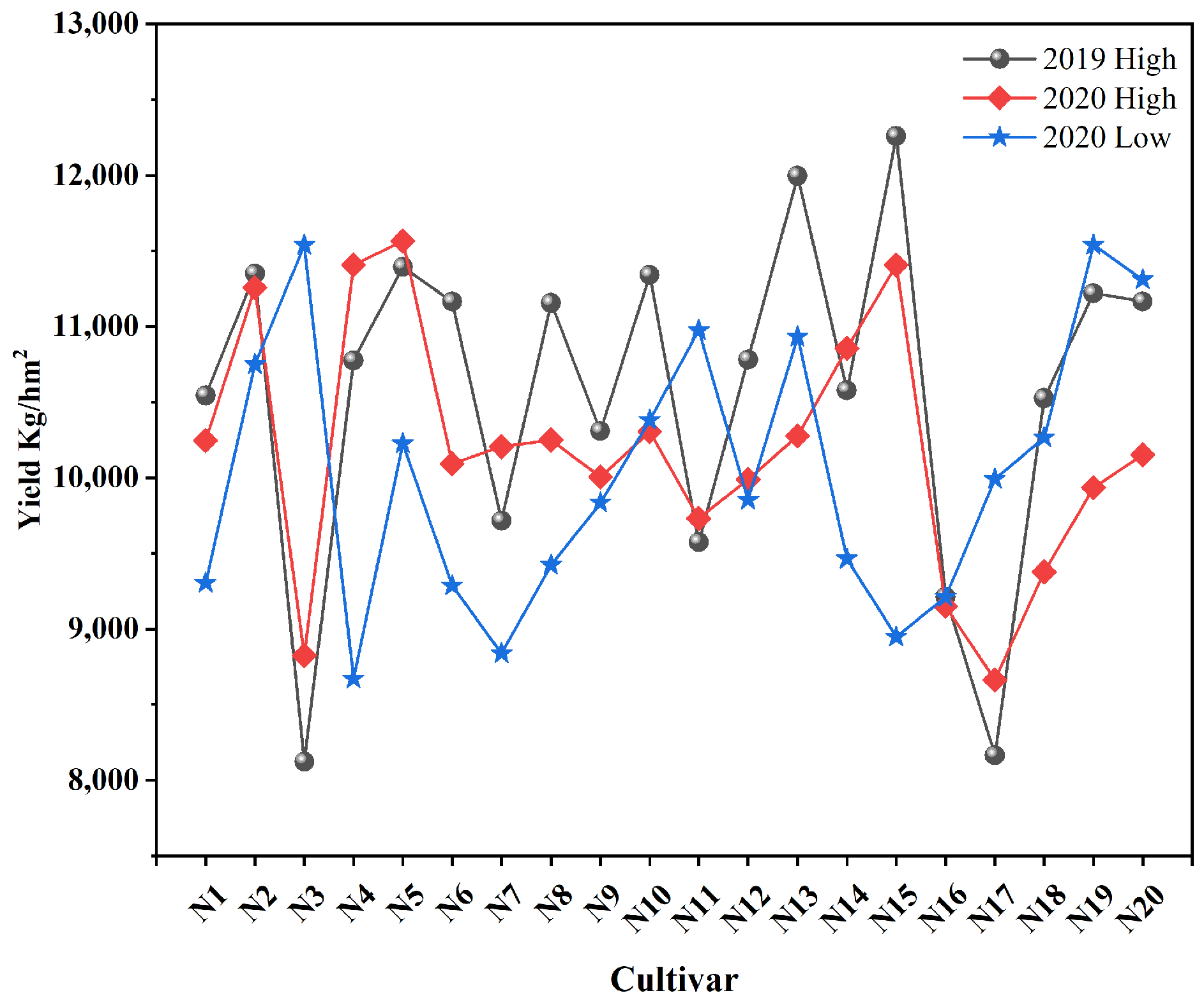
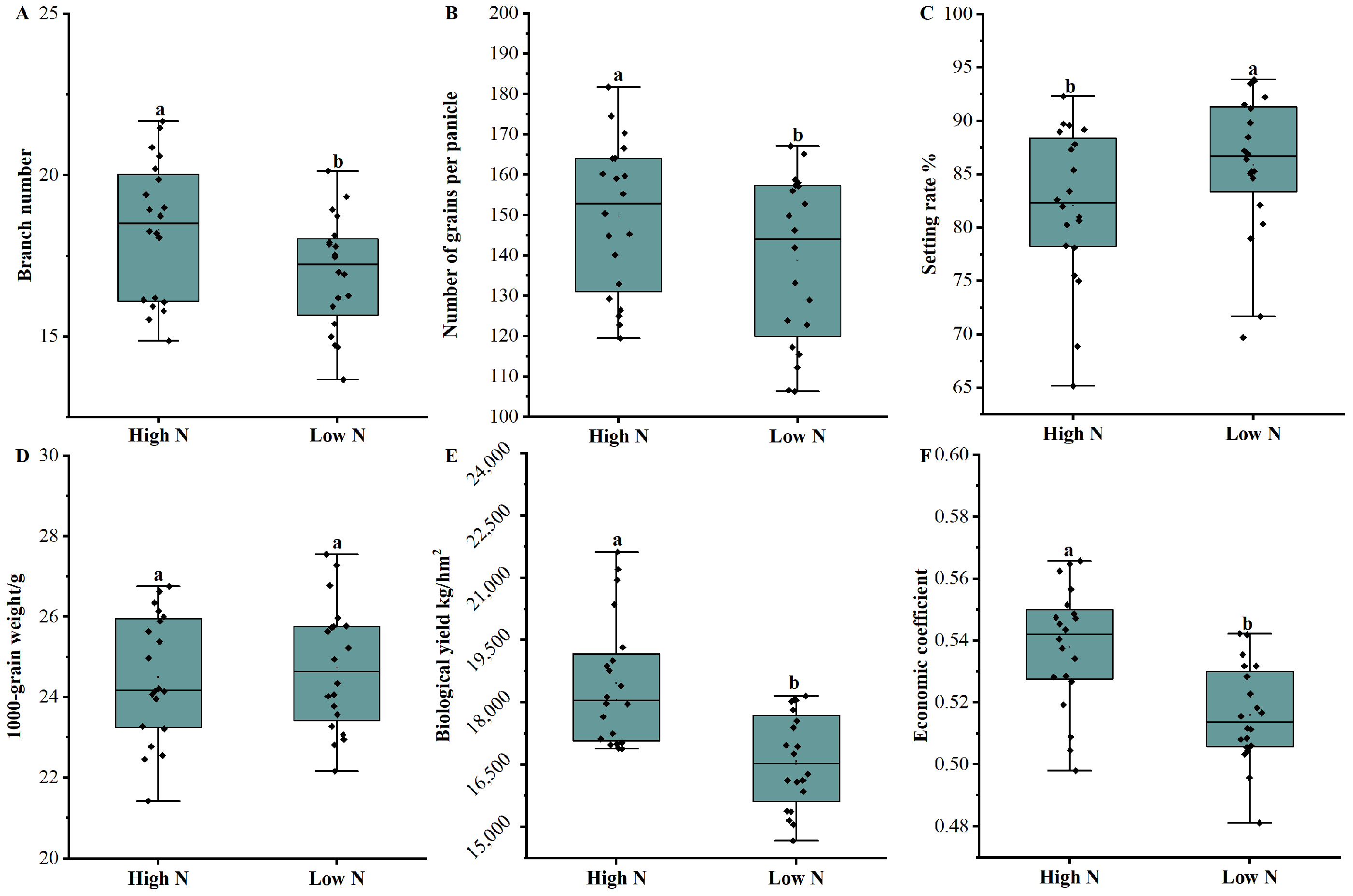
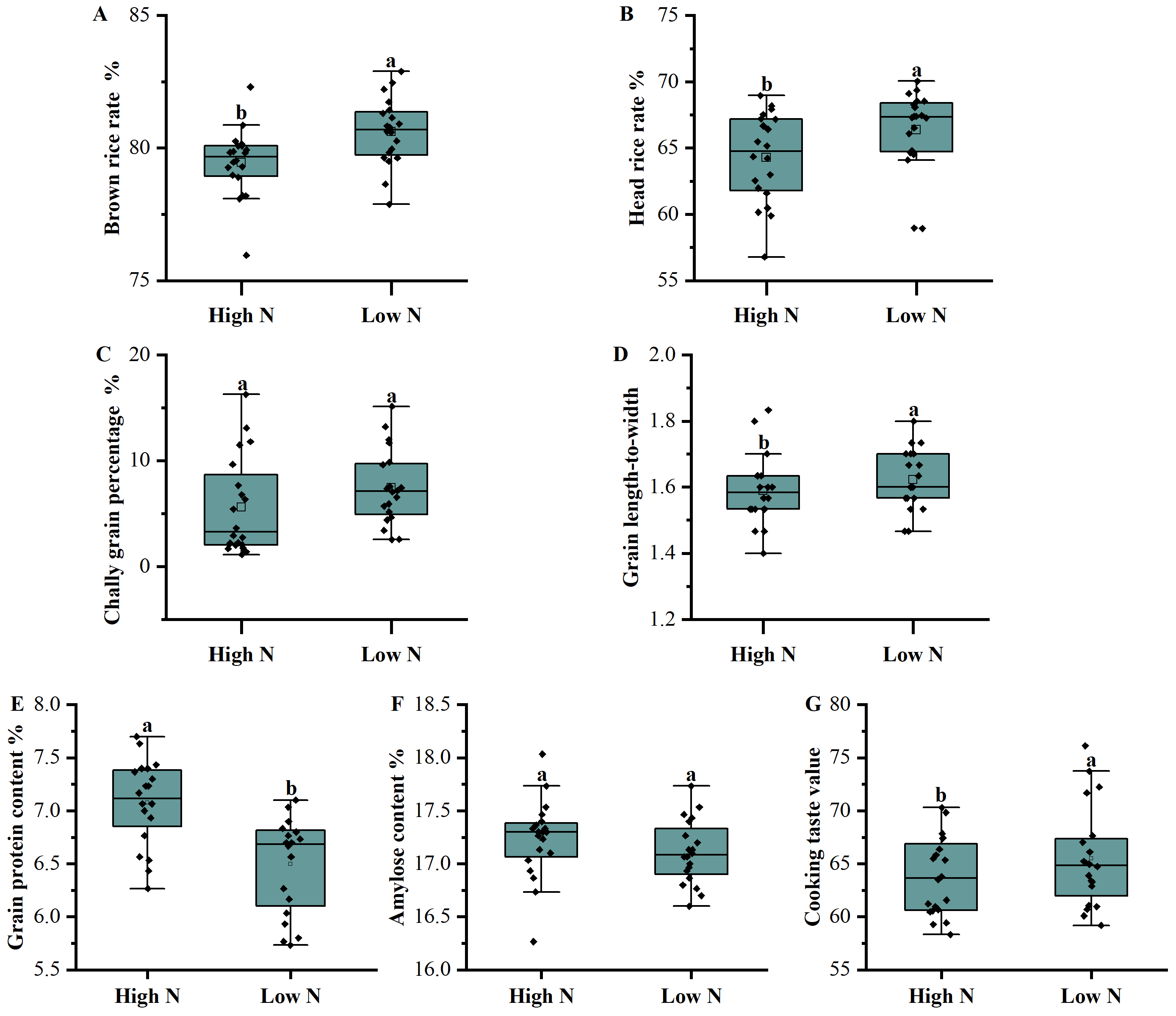
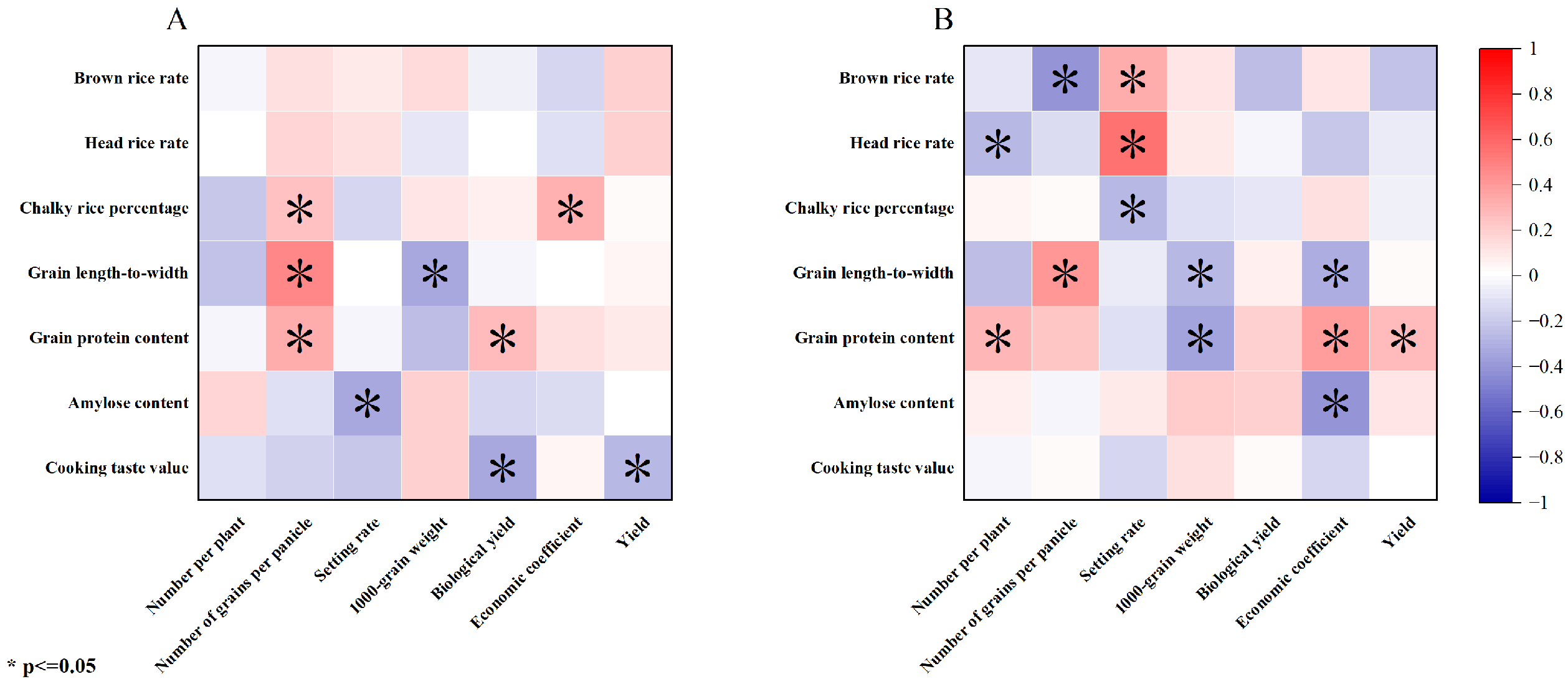
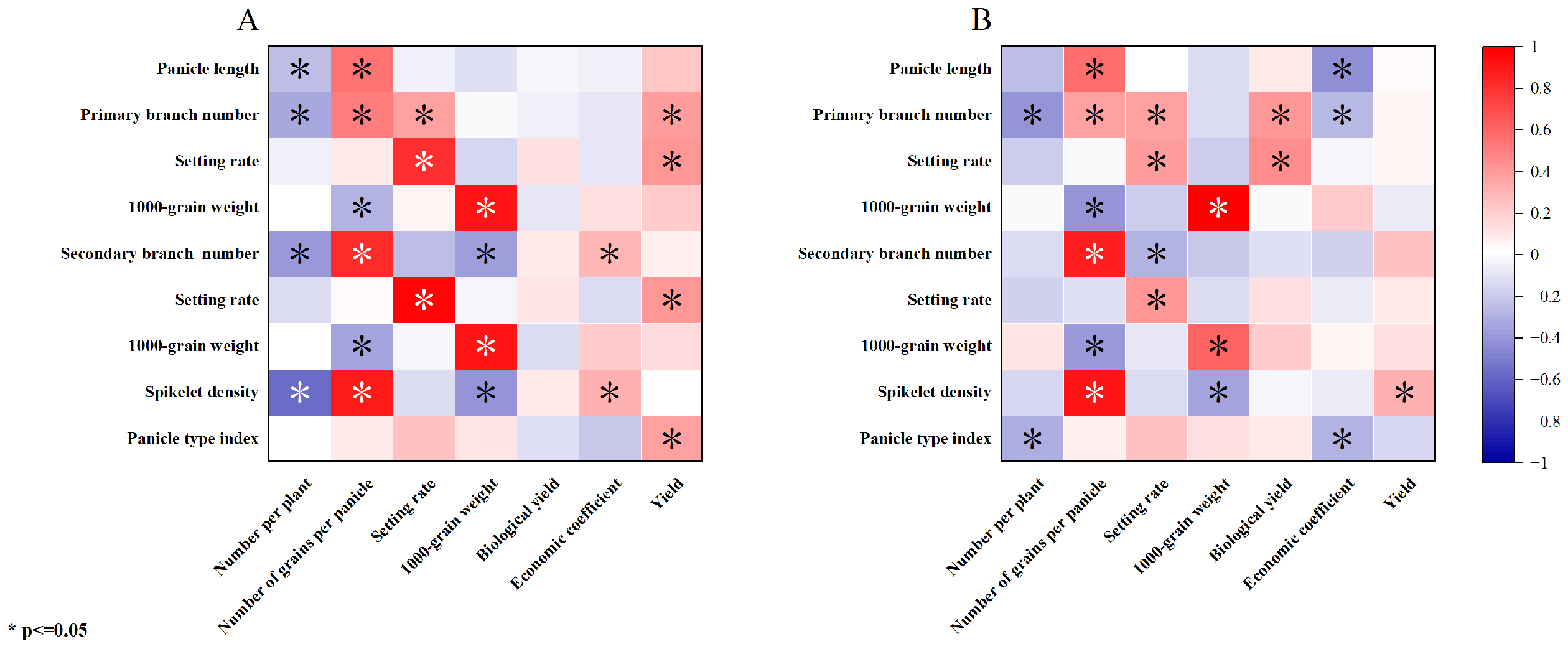
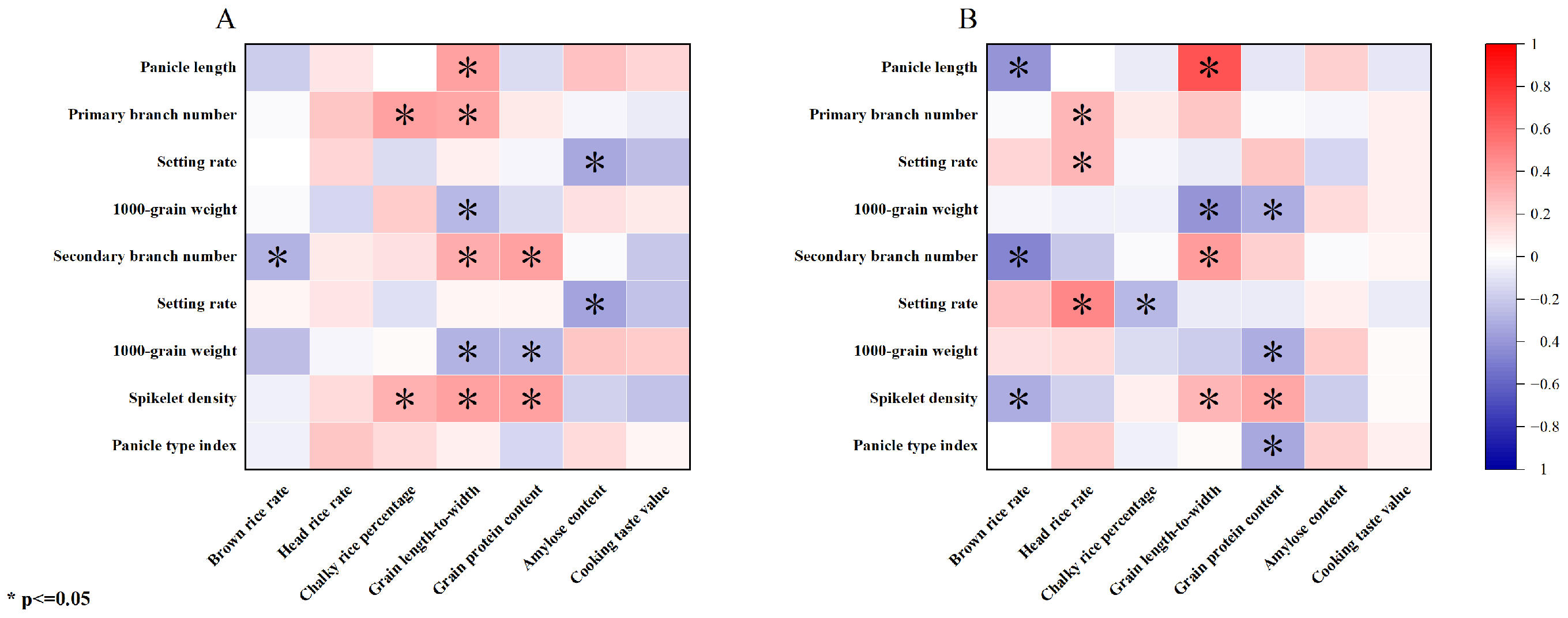
| Trait | Fertilizer Model | High Yield | Intermediate Yield | Low Yield |
|---|---|---|---|---|
| Panicle number | High | 20.01 ± 3.11 a | 16.71 ± 3.32 b | 16.09 ± 3.85 b |
| Low | 16.62 ± 3.21 a | 16.39 ± 3.14 a | 14.79 ± 2.79 b | |
| Number of grains per panicle | High | 152.43 ± 10.68 a | 153.09 ± 7.88 a | 148.59 ± 8.87 a |
| Low | 130.81 ± 8.46 b | 148.13 ± 7.79 a | 135.25 ± 8.54 b | |
| Setting rate (%) | High | 84.62 ± 2.62 a | 82.55 ± 2.52 b | 82.28 ± 2.33 b |
| Low | 86.32 ± 1.53 a | 84.63 ± 1.51 b | 86.28 ± 1.21 a | |
| 1000-grain weight (g) | High | 25.69 ± 2.78 a | 25.01 ± 1.97 b | 23.58 ± 1.41 b |
| Low | 25.40 ± 3.21 a | 25.34 ± 3.14 a | 23.68 ± 2.72 b | |
| Grain yield kg/hm2 | High | 10,468.22 ± 331.88 a | 9413.93 ± 295.93 b | 8669.67 ± 263.32 c |
| Low | 8472.01 ± 299.47 a | 8312.89 ± 370.71 a | 8048.26 ± 277.86 b |
| Traits | High Nitrogen | Low Nitrogen | |
|---|---|---|---|
| Primary branch | Branch number | 11.20 ± 1.16 a | 12.42 ± 1.13 a |
| Setting rate (%) | 93.54 ± 0.23 b | 95.45 ± 0.22 a | |
| 1000-grain weight (g) | 25.75 ± 1.51 b | 26.51 ± 1.69 a | |
| Secondary branch | Branch number | 27.40 ± 4.93 a | 25.31 ± 6.24 b |
| Setting rate (%) | 72.97 ± 0.12 b | 77.64 ± 0.12 a | |
| 1000-grain weight (g) | 22.93 ± 1.88 a | 23.31 ± 1.62 a | |
| Panicle length (cm) | 17.13 ± 0.82 a | 16.87 ± 0.99 b | |
| Spikelet density/10 cm | 86.91 ± 9.72 a | 83.86 ± 11.52 b | |
| Traits | Fertilizer Model | High Yield | Intermediate Yield | Low Yield |
|---|---|---|---|---|
| Brown rice rate (%) | High | 76.53 ± 3.40 a | 75.44 ± 2.87 a | 73.98 ± 2.18 b |
| Low | 80.49 ± 1.33 a | 78.73 ± 1.65 a | 78.24 ± 1.02 a | |
| Head rice rate (%) | High | 52.72 ± 0.99 c | 57.27 ± 1.08 b | 58.48 ± 1.11 a |
| Low | 60.85 ± 1.14 b | 57.13 ± 1.07 c | 61.55 ± 1.16 a | |
| Chalky rice percentage (%) | High | 25.05 ± 3.19 b | 26.06 ± 4.15 a | 26.17 ± 3.92 a |
| Low | 27.78 ± 3.59 a | 27.33 ± 4.94 a | 27.87 ± 4.83 a | |
| Grain length-to-width ratio | High | 1.62 ± 0.03 b | 1.62 ± 0.02 b | 1.66 ± 0.04 a |
| Low | 1.61 ± 0.03 b | 1.62 ± 0.05 b | 1.68 ± 0.03 a | |
| Grain protein content (%) | High | 7.29 ± 0.02 a | 7.28 ± 0.05 a | 7.04 ± 0.07 b |
| Low | 6.88 ± 0.09 a | 6.61 ± 0.12 a | 6.46 ± 0.16 a | |
| Amylose content (%) | High | 17.23 ± 0.49 a | 16.81 ± 0.37 a | 16.91 ± 0.37 a |
| Low | 16.44 ± 0.18 a | 15.98 ± 0.38 a | 16.12 ± 0.38 a | |
| Cooking taste value | High | 62.71 ± 1.22 b | 65.76 ± 1.20 b | 65.4 ± 1.17 a |
| Low | 64.18 ± 1.21 b | 67.51 ± 1.23 a | 66.35 ± 1.19 a |
| Trait | Fertilizer Model | High Yield | Intermediate Yield | Low Yield | |
|---|---|---|---|---|---|
| Primary branch | Branch number | High | 11.88 ± 3.36 b | 12.51 ± 2.38 a | 12.86 ± 3.39 a |
| Low | 11.64 ± 2.35 b | 12.21 ± 2.01 ab | 12.59 ± 2.48 a | ||
| Setting rate (%) | High | 96.26 ± 3.36 a | 94.75 ± 4.39 b | 94.40 ± 4.36 b | |
| Low | 96.25 ± 4.44 a | 95.11 ± 3.59 a | 93.83 ± 4.01 a | ||
| 1000-grain weight (g) | High | 26.52 ± 1.77 a | 26.63 ± 1.68 a | 24.89 ± 1.58 b | |
| Low | 26.28 ± 1.86 b | 27.42 ± 1.63 a | 25.59 ± 1.78 b | ||
| Secondary branch | Branch number | High | 30.06 ± 4.91 a | 26.48 ± 3.84 b | 25.91 ± 2.79 b |
| Low | 26.27 ± 3.80 a | 26.39 ± 3.68 a | 23.39 ± 3.21 b | ||
| Setting rate (%) | High | 74.09 ± 2.25 a | 70.07 ± 2.83 b | 70.42 ± 2.15 b | |
| Low | 77.3 ± 3.35 a | 74.72 ± 2.94 b | 75.04 ± 2.28 b | ||
| 1000-grain weight (g) | High | 23.59 ± 0.92 a | 22.72 ± 0.69 b | 22.32 ± 0.38 b | |
| Low | 24.89 ± 0.96 a | 22.96 ± 0.78 b | 21.73 ± 0.66 b | ||
| Panicle length (cm) | High | 17.67 ± 2.11 a | 16.7 ± 3.15 b | 16.09 ± 3.35 b | |
| Low | 16.62 ± 1.21 a | 16.39 ± 1.14 a | 14.79 ± 2.29 b | ||
| Spikelet density/10 cm | High | 89.98 ± 8.73 a | 84.44 ± 5.69 b | 82.55 ± 6.51 b | |
| Low | 84.53 ± 4.69 a | 80.46 ± 4.57 b | 78.23 ± 3.38 b | ||
| Panicle type index | High | 0.45 ± 0.01 b | 0.47 ± 0.01 a | 0.45 ± 0.01 b | |
| Low | 0.47 ± 0.01 a | 0.43 ± 0.01 c | 0.46 ± 0.01 b | ||
| Traits | Fertilizer Model | High Cooking Taste | Intermediate Cooking Taste | Low Cooking Taste |
|---|---|---|---|---|
| Panicle number | High | 15.93 ± 3.34 b | 16.28 ± 2.41 b | 17.6 ± 1.93 a |
| Low | 15.65 ± 1.41 a | 15.55 ± 2.33 a | 14.97 ± 1.62 a | |
| Number of grains per panicle | High | 142.43 ± 12.68 c | 153.09 ± 10.88 a | 152.59 ± 12.47 b |
| Low | 130.81 ± 15.46 a | 138.13 ± 13.79 a | 135.25 ± 12.54 a | |
| Setting rate (%) | High | 84.96 ± 2.59 a | 81.43 ± 2.53 b | 79.85 ± 2.41 c |
| Low | 89.02 ± 2.49 a | 84.05 ± 1.88 b | 84.65 ± 1.27 b | |
| Grain weight (g) | High | 24.91 ± 1.47 a | 24.69 ± 0.99 a | 24.47 ± 0.46 a |
| Low | 25.84 ± 0.88 a | 24.38 ± 0.76 b | 24.12 ± 0.95 c | |
| Yield kg/hm2 | High | 9483.55 ± 278.42 b | 9526.66 ± 289.23 a | 9653.6 ± 277.86 a |
| Low | 8429.31 ± 264.23 b | 8652.34 ± 275.95 a | 8602.04 ± 265.62 a |
| Traits | Fertilizer Model | High Cooking Taste | Intermediate Cooking Taste | Low Cooking Taste |
|---|---|---|---|---|
| Brown rice rate (%) | High | 76.68 ± 4.49 a | 75.76 ± 1.24 a | 73.52 ± 3.66 a |
| Low | 78.74 ± 3.29 a | 81.28 ± 4.49 a | 81.13 ± 2.46 a | |
| Polish rice rate (%) | High | 54.74 ± 2.66 b | 58.67 ± 2.81 a | 54.47 ± 1.95 b |
| Low | 60.95 ± 1.85 a | 60.75 ± 1.85 a | 57.23 ± 1.74 b | |
| Chalky rice percentage (%) | High | 25.12 ± 3.19 b | 24.11 ± 4.12 c | 26.48 ± 3.23 a |
| Low | 27.32 ± 3.39 b | 28.72 ± 4.41 a | 26.92 ± 4.36 b | |
| Grain length-to-width ratio | High | 1.54 ± 0.07 c | 1.57 ± 0.05 b | 1.65 ± 0.10 a |
| Low | 1.59 ± 0.11 c | 1.66 ± 0.05 a | 1.63 ± 0.05 b | |
| Grain protein content (%) | High | 6.84 ± 0.05 b | 7.16 ± 0.13 ab | 7.57 ± 0.17 a |
| Low | 6.57 ± 0.09 b | 6.81 ± 0.23 a | 6.82 ± 0.18 a | |
| Amylose content (%) | High | 16.33 ± 3.62 a | 16.22 ± 4.61 a | 16.06 ± 3.55 a |
| Low | 17.71 ± 2.33 a | 16.77 ± 4.36 a | 16.46 ± 3.38 a | |
| Cooking taste value | High | 63.28 ± 0.66 a | 63.74 ± 1.67 a | 61.26 ± 1.86 b |
| Low | 70.87 ± 0.71 a | 64.32 ± 0.64 b | 62.22 ± 0.42 c |
| Traits | Fertilizer Model | High Cooking Taste | Intermediate Cooking Taste | Low Cooking Taste | |
|---|---|---|---|---|---|
| Primary branch | Branch number | High | 13.29 ± 1.49 a | 12.25 ± 1.23 a | 12.36 ± 1.41 a |
| Low | 12.32 ± 1.17 b | 12.37 ± 1.11 b | 13.12 ± 1.23 a | ||
| Setting rate (%) | High | 92.31 ± 0.28 a | 91.70 ± 0.95 a | 90.73 ± 0.34 a | |
| Low | 95.83 ± 0.26 a | 94.01 ± 0.63 ab | 93.04 ± 0.42 b | ||
| 1000-grain weight (g) | High | 25.84 ± 1.28 a | 25.19 ± 1.27 a | 24.39 ± 0.61 b | |
| Low | 26.83 ± 0.69 a | 26.53 ± 0.52 a | 25.25 ± 0.47 b | ||
| Secondary branch | Branch number | High | 25.83 ± 3.28 b | 28.62 ± 3.11 a | 28.32 ± 3.32 a |
| Low | 23.71 ± 2.45 a | 24.46 ± 3.38 a | 24.64 ± 2.35 a | ||
| Setting rate (%) | High | 76.54 ± 1.86 a | 72.88 ± 1.37 b | 69.41 ± 1.31 b | |
| Low | 82.52 ± 1.71 a | 76.22 ± 1.43 b | 74.55 ± 1.55 b | ||
| 1000-grain weight (g) | High | 24.88 ± 0.84 a | 24.09 ± 0.43 a | 22.23 ± 0.62 b | |
| Low | 25.99 ± 1.47 a | 22.06 ± 1.23 b | 22.16 ± 0.34 b | ||
| Panicle length (cm) | High | 17.36 ± 3.16 a | 17.83 ± 2.01 a | 15.42 ± 3.11 b | |
| Low | 16.53 ± 2.27 a | 16.42 ± 1.35 a | 16.35 ± 0.81 a | ||
| Spikelet density/10 cm | High | 83.29 ± 7.57 b | 87.14 ± 8.64 b | 90.64 ± 8.71 a | |
| Low | 80.61 ± 6.52 b | 87.88 ± 7.65 a | 82.45 ± 6.55 b | ||
| Panicle type index | High | 0.47 ± 0.01 a | 0.45 ± 0.01 b | 0.43 ± 0.01 c | |
| Low | 0.48 ± 0.01 a | 0.46 ± 0.01 b | 0.44 ± 0.01 c | ||
| Cultivars | Growth Days (d) | Plant Height (cm) | Tiller Ability | Panicle Type | Breeding Institution |
|---|---|---|---|---|---|
| Beijing 1 | 154 | 105.0 | Intermediate | Erect | Shenyang Agricultural University, Shenyang, Liaoning, China |
| Beijing 2 | 155 | 106.4 | Strong | Erect | Shenyang Agricultural University, Shenyang, Liaoning, China |
| Beijing 3 | 154 | 101.4 | Strong | Erect | Shenyang Agricultural University, Shenyang, Liaoning, China |
| Beijing 1501 | 159 | 104.9 | Moderate | Semi-erect | Shenyang Agricultural University, Shenyang, Liaoning, China |
| Beijing 1604 | 152 | 103.6 | Strong | Erect | Shenyang Agricultural University, Shenyang, Liaoning, China |
| Shendao 47 | 155 | 105.0 | Strong | Semi-erect | Shenyang Agricultural University, Shenyang, Liaoning, China |
| Liaojing 1415 | 155 | 104.6 | Moderate | Semi-erect | Liaoning Rice Research Institute, Shenyang Agricultural University, Shenyang, Liaoning, China |
| Liaojing 401 | 158 | 105.2 | Intermediate | Erect | Liaoning Rice Research Institute, Shenyang Agricultural University, Shenyang, Liaoning, China |
| Liaojing 399 | 154 | 110.1 | Moderate | Erect | Liaoning Rice Research Institute, Shenyang Agricultural University, Shenyang, Liaoning, China |
| Liaojing 212 | 158 | 110.1 | Intermediate | Erect | Liaoning Rice Research Institute, Shenyang Agricultural University, Shenyang, Liaoning, China |
| Tiejing 7 | 156 | 91.1 | Moderate | Erect | Tieling Academy of Agricultural Sciences, Tieling, Liaoning, China |
| Tiejing 11 | 159 | 100.9 | Strong | Semi-erect | Tieling Academy of Agricultural Sciences, Tieling, Liaoning, China |
| Tiejing 20 | 155 | 103.4 | Strong | Semi-erect | Tieling Academy of Agricultural Sciences, Tieling, Liaoning, China |
| Jindao 108 | 156 | 105.4 | Strong | Erect | Panjin North Agricultural Technology Development Co., Ltd., Panjin, Liaoning, China |
| Jindao 201 | 157 | 92.9 | Strong | Erect | Panjin North Agricultural Technology Development Co., Ltd., Panjin, Liaoning, China |
| Jindao 104 | 159 | 94.5 | Strong | Erect | Panjin North Agricultural Technology Development Co., Ltd., Panjin, Liaoning, China |
| Yanjing 765 | 156 | 100.1 | Strong | Semi-erect | Liaoning Institute of Saline-alkali Land Utilization, Panjin, Liaoning, China |
| Yanjing 662 | 157 | 97.6 | Strong | Erect | Liaoning Institute of Saline-alkali Land Utilization, Panjin, Liaoning, China |
| Fuhe 5 | 156 | 100.0 | Moderate | Semi-erect | Liaoning Dong-A Seed Industry Co., Ltd., Shenyang, Liaoning, China |
| Meifengdao 669 | 154 | 108.8 | Moderate | Semi-erect | Liaoning Dong-A Seed Industry Co., Ltd., Shenyang, Liaoning, China |
Disclaimer/Publisher’s Note: The statements, opinions and data contained in all publications are solely those of the individual author(s) and contributor(s) and not of MDPI and/or the editor(s). MDPI and/or the editor(s) disclaim responsibility for any injury to people or property resulting from any ideas, methods, instructions or products referred to in the content. |
© 2024 by the authors. Licensee MDPI, Basel, Switzerland. This article is an open access article distributed under the terms and conditions of the Creative Commons Attribution (CC BY) license (https://creativecommons.org/licenses/by/4.0/).
Share and Cite
Yan, B.; Jiang, X.; Xu, Z.; Chen, W.; Cheng, X.; Xu, H. Analysis of Erect-Panicle Japonica Rice in Northern China: Yield, Quality Status, and Quality Improvement Directions. Plants 2024, 13, 926. https://doi.org/10.3390/plants13070926
Yan B, Jiang X, Xu Z, Chen W, Cheng X, Xu H. Analysis of Erect-Panicle Japonica Rice in Northern China: Yield, Quality Status, and Quality Improvement Directions. Plants. 2024; 13(7):926. https://doi.org/10.3390/plants13070926
Chicago/Turabian StyleYan, Bingchun, Xinmei Jiang, Zhengjin Xu, Wenfu Chen, Xiaoyi Cheng, and Hai Xu. 2024. "Analysis of Erect-Panicle Japonica Rice in Northern China: Yield, Quality Status, and Quality Improvement Directions" Plants 13, no. 7: 926. https://doi.org/10.3390/plants13070926
APA StyleYan, B., Jiang, X., Xu, Z., Chen, W., Cheng, X., & Xu, H. (2024). Analysis of Erect-Panicle Japonica Rice in Northern China: Yield, Quality Status, and Quality Improvement Directions. Plants, 13(7), 926. https://doi.org/10.3390/plants13070926





